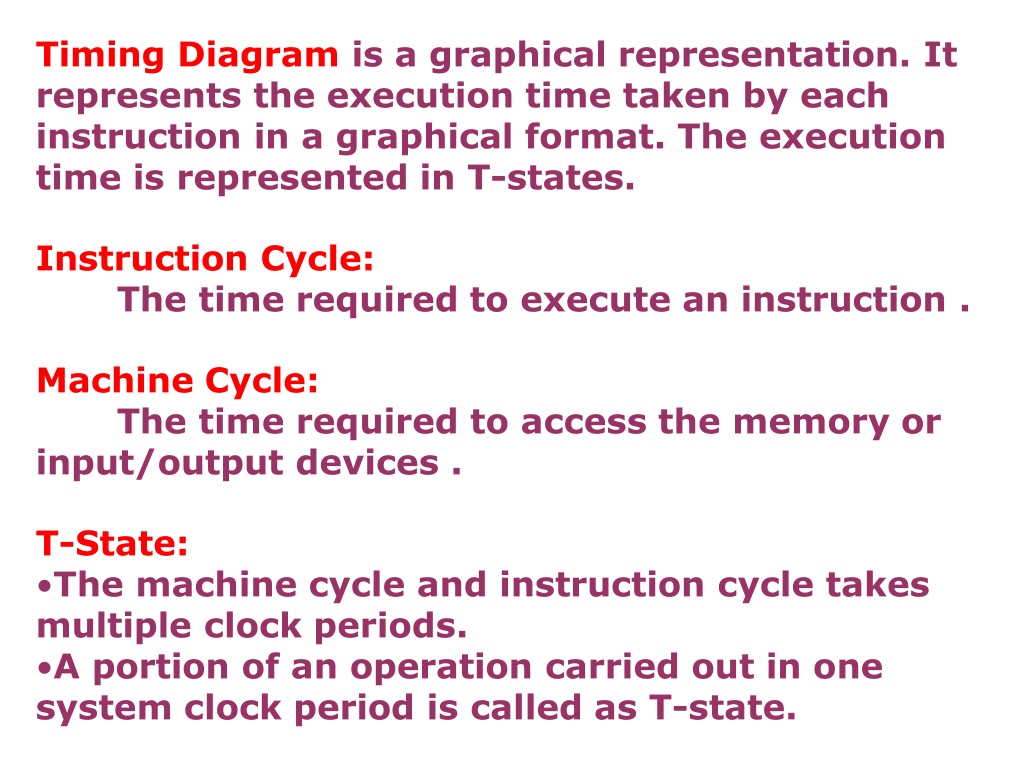Understanding Timing Diagrams and Machine Cycles in Microprocessors
Timing diagrams provide a visual representation of execution times for instructions in a microprocessor, measured in T-states. This content delves into the concept of machine cycles, such as Opcode fetch cycle and Memory read cycle, in 8085 microprocessors. Exploring the T-states within each cycle, it explains the process of fetching, reading, and decoding instructions in detail.
Download Presentation

Please find below an Image/Link to download the presentation.
The content on the website is provided AS IS for your information and personal use only. It may not be sold, licensed, or shared on other websites without obtaining consent from the author. Download presentation by click this link. If you encounter any issues during the download, it is possible that the publisher has removed the file from their server.
E N D
Presentation Transcript
Timing Diagram is a graphical representation. It represents the execution time taken by each instruction in a graphical format. The execution time is represented in T-states. Instruction Cycle: The time required to execute an instruction . Machine Cycle: The time required to access the memory or input/output devices . T-State: The machine cycle and instruction cycle takes multiple clock periods. A portion of an operation carried out in one system clock period is called as T-state.
Timing diagrams The 8085 microprocessor has 7 basic machine cycle. They are 1. Op-code Fetch cycle(4T or 6T). 2. Memory read cycle (3T) 3. Memory write cycle(3T) 4. I/O read cycle(3T) 5. I/O write cycle(3T) 6. Interrupt Acknowledge cycle(6T or 12T) 7. Bus idle cycle
OPCODE FETCH The Opcode fetch cycle, fetches the instructions from memory and deliversit to the instruction register of the microprocessor Opcode fetch machine cycle consistsof 4 T-states. T1 State: During the T1 state, the contents of the program counter are placed on the 16 bit address bus. The higher order 8 bits are transferred to address bus (A8-A15) and lower order 8 bits are transferred to multiplexed A/D (AD0-AD7) bus. ALE (address latch enable) signal goes high. As soon as ALE goes high, the memory latches the AD0-AD7 bus. At the middle of the T state the ALE goes low
T2 State: During the beginningof this state, the RD signal goes low to enable memory. It is during this state, the selected memory location is placed on D0-D7 of the Address/Data multiplexed bus. T3 State: In the previous state the Opcode is placed in D0-D7 of the A/D bus. In this state of the cycle, the Opcode of the A/D bus is transferred to the instruction register of the microprocessor. Now the RD goes high after this actionand thus disables the memory from A/D bus. T4 State: In this state the Opcode which was fetched from the memory is decoded.
These machine cycles have 3 T-states. T1 state: The higher order address bus (A8-A15) and lower order address and data multiplexed (AD0-AD7) bus. ALE goes high so that the memory latches the (AD0-AD7) so that complete 16-bit address are available. The mp identifies the memory read machine cycle from the status signals IO/M =0, S1=1, S0=0. This condition indicates the memory read cycle. T2state: Selected memory location is placed on the (D0-D7) of the A/D multiplexed bus. RD goes LOW T3State: The data which was loaded on the previous state is transferred to the microprocessor.In the middle of the T3 state RD goes high and disables the memory read operation. The data which was obtained from the memory is then decoded.
These machine cycles have 3 T-states. T1 state: The higher order address bus (A8-A15) and lower order address and data multiplexed (AD0-AD7) bus. ALE goes high so that the memory latches the (AD0-AD7) so that complete 16-bit address are available. The mp identifies the memory read machine cycle from the status signals IO/M =0, S1=0, S0=1. This condition indicates the memory read cycle. T2state: Selected memory location is placed on the (D0-D7) of the A/D multiplexed bus. WR goes LOW T3State: In the middle of the T3 state WR goes high and disables the memory write operation. The data which was obtained from the memory is then decoded.
STA instruction ex: STA 526A
It require 4 m/c cycles 13 T states 1.opcode fetch(4T) 2.memory read(3T) 3.memory read(3T) 4.Memory write(3T)
Timing diagram for IN C0H Fetching the Opcode DBH from the memory 4125H. Read the port address C0H from 4126H. Read the content of port C0H and send it to the accumulator. Let the content of port is 5EH.
It require 3 m/c cycles 10 T states opcode fetch(4T) memory read(3T) I/O read(3T)
OUT instruction Machines Cycles(10T): 1.instruction fetch(4T) 2.memory read (3T) 3.IO write (3T)
Timing diagram for MVI B, 43h Fetching the Opcode 06H from the memory 2000H. (OF machine cycle) Read (move) the data 43H from memory 2001H. (memory read)
references 8085 microprocessor by Sajid Akram, researcher/lecturer at c.abdul hakeem college of engineering and technology Timingdiagram by puja00 (slideshare.net) Microprocessor 8086 by Gopikrishna Madanan, Assistant Professor of Physics at Collegiate Education, Kerala, India























